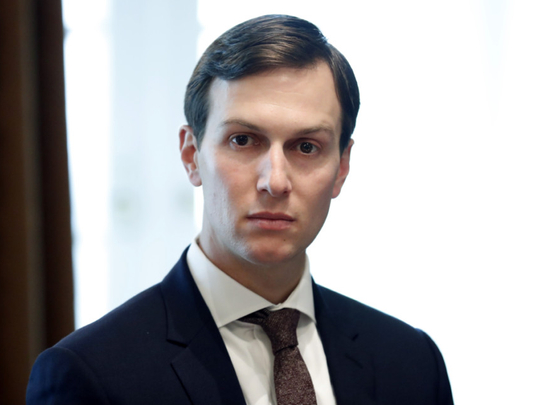
According to the United States and Israeli sources, the administration of US President Donald Trump is putting the final touches to its Middle East peace plan and is likely to unveil it in a major ceremony in Washington early next year. Dubbed as “the ultimate deal”, the proposal aims at securing a final settlement to the Palestinian-Israeli conflict as part of a larger regional setup that finally ends Arab-Israeli hostilities and normalises relations between the two sides.
The team entrusted by Trump to produce such a deal is made up of his son-in-law Jared Kushner, the president’s Special Middle East Envoy Jason Greenblatt, Deputy National Security Adviser Dina Powell and US Ambassador to Israel David Freedman. Kushner, Greenblatt and Freedman are Orthodox Jews with close ties to Israel’s right-wing and in particular to Israeli Prime Minister Benjamin Netanyahu. Kushner and aides have made a number of visits to the region since taking the job ten months ago, holding open and secret meetings with key Israeli, Palestinian and Arab officials. But those who attended some of those meetings with Palestinian President Mahmoud Abbas say that Kushner was more of a listener than a negotiator; keeping his cards close to his chest.
Trump’s Middle East team has been described by the US press as naive and inexperienced. Those close to the White House say Kushner and Greenblatt believe that going into the recent history of negotiations will not bring Israel and the Palestinians any closer. Instead, they would rather skim through historic complications and focus on what is possible and achievable. Such a position would waive aside reams of previous agreements and commitments, not to mention pertinent United Nations resolutions and international statute, in favour of expedient solutions that enshrine Israeli unilateral measures in the West Bank and occupied East Jerusalem.
Such an approach would oppose consistent US policy since the signing of the Oslo accords in Washington between Israel and the Palestine Liberation Organisation in 1993. More importantly, it would be aligned with many of the positions that Netanyahu and some of his right-wing coalition members espouse. For the Palestinians, bypassing previous agreements and ignoring UN resolutions on the conflict means that the classical two-state solution that the Palestinian leadership is committed to would be a thing of the past.
The bedrock of the Kushner deal, if it ever materialises, would be the 2002 Arab Peace Initiative. But what he and Netanyahu would like to do is to deconstruct that Arab League resolution and rebuild it again. Instead of implementing the initiative from the top down; Israeli withdrawal from the West Bank, occupied East Jerusalem and all Occupied Territories in return for full recognition and normalisation of relations with the Arab and Muslim worlds, Kushner’s proposal would enforce a settlement — a take-it-or-leave-it approach — in exchange for immediate steps towards open ties with Arab countries, especially Gulf states.
The proposed deal would rest on a two-state solution parameters; expanding the Palestinian National Authority’s (PNA) area of control over West Bank territories, inclusion of some Jewish colonies into Palestinian areas but colonists will be under Israeli law, a subtle freeze on colony building, including in occupied East Jerusalem, and a generous economic aid to the Palestinians. If the Palestinians want to declare areas under their control as a state — they already behave as a state — then that would be fine. Other thorny issues such as refugees, Jordan Valley, security, water and final borders will be worked out later, but will not be a deal breaker.
Netanyahu, whose commitment to the classical two-state solution has always been in doubt, should be delighted. But with no US and international leverage on Israel at this moment of time, he and his right-wing partners will want more while giving less — or nothing in return.
The success of the Kushner deal hinges on timing. The region is in turmoil and as we enter a post-Daesh (the self-proclaimed Islamic State of Iraq and the Levant) era, the focus will be on Iran as the most immediate threat to America’s regional allies. By simplifying a decades-old conflict — thinking out of the box in the words of Netanyahu — the Trump team hopes to bond together old enemies to confront a relatively new and common one.
But the scheme has flaws. It is not up to Abbas to approve a solution that falls short of the goals of the historic struggle of the Palestinian people. Furthermore, the fate of millions of Palestinian refugees requires approval by host countries and that is a complex issue. And finally, a solution that does not recognise Palestinian rights in Arab East Jerusalem will be rejected by Arabs and Muslims alike.
In anticipation of the proposed deal, the Netanyahu government has accelerated plans to evict Palestinians from the Jordan Valley and occupied East Jerusalem. Moreover, there is one major shortcoming in the Kushner approach: The steadfastness of the Palestinian people. Writing off their legitimate rights as a nation will cripple any master plan for the region. An ultimate deal may be an illusion and a high-risk game for now.
Osama Al Sharif is a journalist and political commentator based in Amman.









